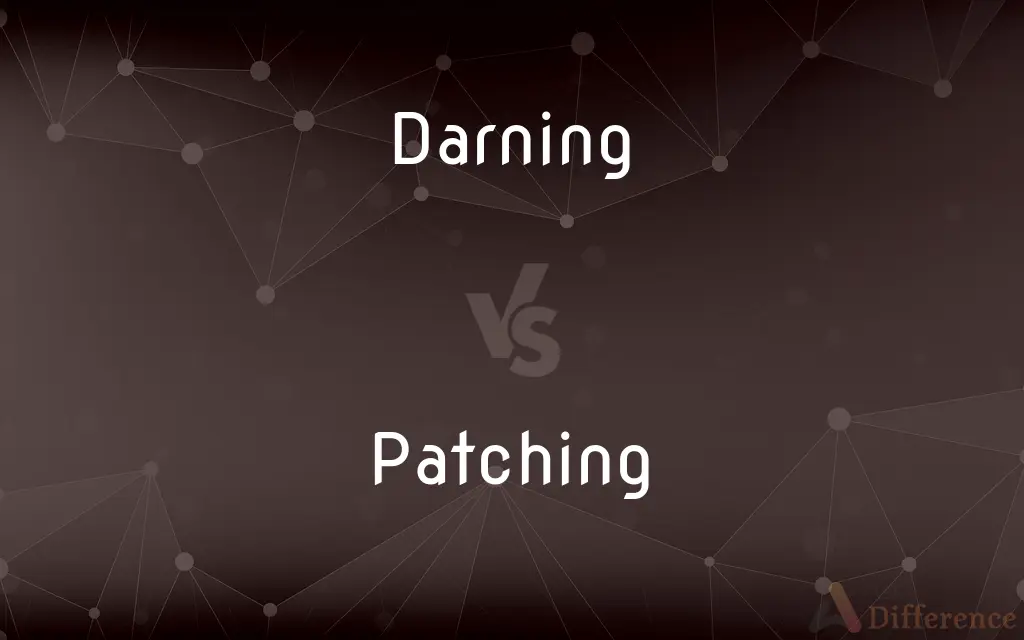Darning vs. Patching — What's the Difference?
By Tayyaba Rehman & Urooj Arif — Updated on March 6, 2024
Darning involves weaving threads into a fabric to repair holes, while patching covers holes with a piece of fabric, offering a more visible fix.

Difference Between Darning and Patching
Table of Contents
ADVERTISEMENT
Key Differences
Darning is a traditional method used to repair holes or worn areas in fabric, especially in knitwear and socks. It involves interweaving yarn or thread with a needle to fill in gaps without adding bulk, creating a seamless repair that blends with the original fabric. On the other hand, patching involves placing a piece of fabric over a hole or worn area and securing it, either by sewing or adhesive means. Patches can be made from matching or contrasting fabric, offering both a functional repair and a decorative element.
While darning is particularly effective for small holes and thin materials like socks, where preserving the garment's original feel and flexibility is important, patching is better suited for larger holes, heavy-duty materials like denim, or when the repair needs to provide extra strength. Patching can also serve as a creative way to personalize or embellish clothing.
Darning requires a certain level of skill and patience, as it involves creating a weave that mimics the original fabric. This method is less visible and maintains the garment's original texture and weight. Conversely, patching is often quicker and can be easier for beginners, making it a popular choice for fast repairs or adding stylistic touches to clothing.
Darning provides a repair that is integrated into the fabric, which can extend the life of lightweight garments without altering their appearance or feel. Patching, by adding an extra layer, offers robustness and is suitable for areas subject to heavy wear, such as knees and elbows on children's clothing or workwear.
The choice between darning and patching can also reflect a stylistic preference. Darning tends to be chosen for its subtlety and ability to blend into the original fabric, making it ideal for cherished garments where the aim is to restore the item as closely as possible to its original state. Patching, however, allows for creative expression, with the use of decorative patches or contrasting materials that can make a fashion statement or add unique character to an item.
ADVERTISEMENT
Comparison Chart
Method
Weaving threads into fabric
Covering with a piece of fabric
Best For
Small holes, lightweight materials
Larger holes, heavy-duty materials
Skill Level
Requires dexterity and practice
Easier for beginners, quicker
Durability
Integrates with fabric, good for light wear
Adds strength, suitable for heavy wear
Aesthetic
Seamless and subtle
Visible, can be decorative
Compare with Definitions
Darning
Weaving Repair.
Darning socks involves weaving yarn to fill holes seamlessly.
Patching
Fabric Overlay.
Patching jeans involves sewing a new piece of fabric over torn areas.
Darning
Skill Intensive.
Mastering darning requires patience and practice to replicate fabric patterns.
Patching
Beginner-Friendly.
Patching is a quick fix that requires basic sewing skills.
Darning
To mend (a garment, for example) by weaving thread or yarn across a gap or hole.
Patching
Decorative Potential.
Colorful patches add a unique style to jackets and backpacks.
Darning
Lightweight Solution.
Darning is ideal for repairing delicate fabrics without adding bulk.
Patching
Versatile Applications.
Patching works well on a variety of materials, from denim to canvas.
Darning
To repair a hole, as in a garment, by weaving thread or yarn across it.
Patching
The act of mending a hole in a garment by sewing a patch over it
Darning
Subtle Repairs.
Darning can almost invisibly mend tears in knitwear.
Patching
Strengthens Fabric.
A patch can reinforce areas prone to heavy wear, like knee patches on pants.
Darning
Preserves Texture.
Darned areas maintain the original fabric's texture and flexibility.
Patching
The act of one who patches.
Darning
The act of mending a hole in a garment with crossing threads
Patching
The act of mending a hole in a garment by sewing a patch over it.
Darning
Darning is a sewing technique for repairing holes or worn areas in fabric or knitting using needle and thread alone. It is often done by hand, but it is also possible to darn with a sewing machine.
Darning
A repair made by darning.
Common Curiosities
Is darning more durable than patching?
Darning integrates with the fabric and is suitable for light wear areas, while patching is more durable for heavy wear.
When should I choose darning over patching?
Darning is best for small repairs on lightweight fabrics where you want to maintain the original look and feel.
Can patching be used for decorative purposes?
Yes, patching can be both functional and decorative, allowing for creative expression through the use of various fabrics and designs.
Do I need special tools for darning?
Basic tools like a darning needle and yarn are needed, and a darning mushroom or egg can help with socks and small items.
What is darning?
Darning is a repair technique where yarn or thread is woven into a fabric to mend holes or worn areas seamlessly.
Is darning invisible?
Darning can be almost invisible if the yarn or thread closely matches the original fabric.
Can any fabric be patched?
Most fabrics can be patched, but the choice of patch material and method depends on the fabric's type and use.
Can patching alter the feel of the garment?
Yes, adding a patch can change the garment's flexibility or thickness, especially in the repaired area.
How does patching work?
Patching involves covering a damaged area with a new piece of fabric, either by sewing or using an adhesive.
How do I choose the right patch material?
Choose a material that matches the durability and flexibility of the original fabric, and consider whether you want it to blend in or stand out.
How do I care for darned or patched garments?
Care instructions depend on the materials used but generally involve gentle washing to preserve the repair.
Why might someone prefer patching?
Patching is quicker, easier for beginners, and can add a decorative element to the repair.
Is darning suitable for heavy fabrics like denim?
While possible, darning is less commonly used for heavy fabrics, where patching might provide better durability.
Can darning and patching be combined?
Yes, for extensive repairs, darning can be used to strengthen the fabric, followed by patching for additional durability.
What are the advantages of darning?
Darning preserves the fabric's original texture and appearance, making it ideal for valued garments.
Share Your Discovery

Previous Comparison
Bulgarian vs. Macedonian
Next Comparison
Correspond vs. CoincideAuthor Spotlight
Written by
Tayyaba RehmanTayyaba Rehman is a distinguished writer, currently serving as a primary contributor to askdifference.com. As a researcher in semantics and etymology, Tayyaba's passion for the complexity of languages and their distinctions has found a perfect home on the platform. Tayyaba delves into the intricacies of language, distinguishing between commonly confused words and phrases, thereby providing clarity for readers worldwide.
Co-written by
Urooj ArifUrooj is a skilled content writer at Ask Difference, known for her exceptional ability to simplify complex topics into engaging and informative content. With a passion for research and a flair for clear, concise writing, she consistently delivers articles that resonate with our diverse audience.














































